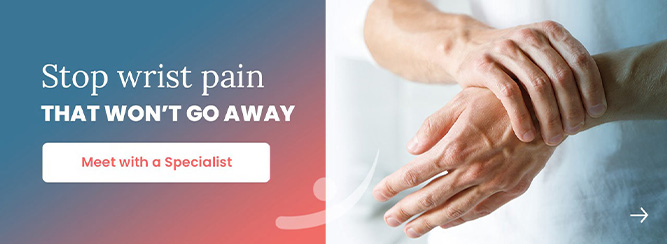Life with a new baby is meant to bring lots of special moments. But for some new moms, they’re stuck suffering from soreness caused by repetitive interactions with their little ones. Healing mommy thumb—the nickname for this common condition (De Quervain’s stenosing tenosynovitis) with a complicated name—starts with seeing a specialist dedicated to treating upper extremity disorders for an accurate diagnosis of what’s causing your discomfort.
You don’t have to live with pain at the base of your thumb up to your wrist that can keep you from fully enjoying motherhood.
Keep reading to learn the signs you might have mommy thumb, when it’s time to see a doctor, and how the tendon problem is treated—plus, what you can do to prevent it.
What Causes Mommy Thumb?
Your tendons are what move your thumb. When your tendons on your wrist’s thumb side become inflamed from overuse, you can feel excruciating pain.
Lifting your baby or toddler, changing their diapers, cradling them while breastfeeding—doing all of these simple movements over and over throughout the day can cause painful inflammation in this area that makes it particularly hard to use do other things, like make a fist, grip something, or even turn your wrist.
You Don’t Have to Be a Mom to Get Mommy Thumb
Anyone can develop De Quervain’s stenosing tenosynovitis, though women are afflicted with the condition 8 to 10 times more often than men. It occurs most often in people between the ages of 30 and 50.
If you regularly engage in activities that require a sideways motion of your wrist while gripping your thumb—like texting or playing games on a smartphone, hammering, skiing, or doing some types of assembly line work—you’re at a higher risk for developing mommy thumb.
Mommy Thumb Symptoms
De Quervain’s stenosing tenosynovitis can seemingly develop overnight or can come on very gradually. Here are some symptoms to look for if you suspect you may be suffering from it:
- The primary symptom is pain over the thumb side of your wrist. That pain may radiate from your thumb and up your forearm.
- Pain becomes worse when using your thumb to grasp, pinch, or twist something.
- You have swelling over the thumb side of your wrist or feel a catching or snapping sensation when moving your thumb.
- Pain and swelling make it challenging to move your thumb and wrist.
Diagnosing and Healing Mommy Thumb
If you have the primary symptom of De Quervain’s stenosing tenosynovitis—pain and swelling over the first dorsal compartment (the thumb side of your wrist)—the next step in diagnosis will typically be Finkelstein’s test.

In this test, you’ll be asked to make a fist with your thumb placed under your fingers. Then you’ll bend your wrist away from your thumb and towards the little finger side of your hand.
While this test can cause mild pain for most people, for someone suffering from mommy thumb, it will feel much more painful and will help the doctor make a proper diagnosis.
For treating and healing mommy thumb, your doctor may start by having you wear a wrist and thumb spica splint and start you on a three to six-week trial of anti-inflammatory medication. They may also choose to inject the area with a small amount of steroid to help with the inflammation and to aid in healing mommy thumb symptoms.
What to Expect if Surgery Is Needed
If the above treatments are not successful at healing mommy thumb and your pain continues, outpatient surgery may be recommended by your doctor.
During the surgery, a surgeon makes an incision over the first dorsal compartment. Then, the ligament that makes up the tunnel’s roof is cut to release the abductor pollicis longus and extensor pollicis brevis tendons. The surgical wound is closed and wrapped in a compressive dressing.
Once the dressing is removed (typically after about five to 14 days), you’ll be given thumb and wrist exercises to perform.
Healing mommy thumb can take several weeks to recover fully, but the condition rarely comes back after a successful surgery.
When to See a Doctor for Mommy Thumb
If your pain doesn’t resolve itself with two to four weeks of rest or if your pain is severe and prevents you from moving your wrist or thumb, see a doctor right away. Be prepared to answer basic questions about your pain. Some questions your provider may ask include:
- What symptoms are you experiencing?
- When did you first notice them?
- Has your pain increased or stayed the same?
- Which activities seem to make your symptoms worse?
- What at-home treatments have you tried?
Get Help Healing Mommy Thumb
If you have wrist pain that won’t go away, it can impact every aspect of your daily life. The experienced wrist specialists at Indiana Hand to Shoulder Center can help you find answers and get pain relief.
“Dr. Fischer is an elite doctor. I feel privileged to have him operate on my wrist and bring me back to a 100% recovery. I would recommend him time after time.”
—Indiana Hand to Shoulder Center wrist pain patient
Stop persistent wrist pain that makes it hard to do what you love. Request an appointment today
Prefer to schedule by phone? Call us at (317) 751-5904.

You Might Also Like ...